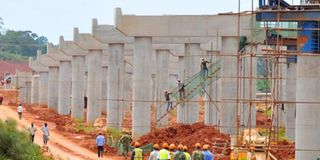More than 10,000 Chinese migrants in Uganda illegally

The Entebbe-Kampala Expressway. Through this and many other infrastructure projects, China has become a development partner for Uganda. FILE PHOTO
What you need to know:
- The current population of China is 1,385,958,346 as of Saturday, February 11, 2017, based on the latest United Nations estimates.
- In the recent years, China’s engagement with Africa in the area of trade has been on the increase. This development has seen so much Chinese goods flooding African countries market but of low quality.
Kampala. The number of illegal (unofficial) Chinese migrants in Uganda ranges from 10,000 to 50,000, a scholar and economic development expert has said.
According to Dr David Dollar, a Senior Fellow in the Foreign Policy, Global Economy and Development programme at the John L. Thornton China Centre of the Brookings Institution, US, the influx of Chinese migrants into Uganda and other African countries is a result of global labour migration.
Currently, an estimated 105 million persons are working in a country other than their country of birth.
Presenting governor’s public lecture series in Kampala last week, Dr Dollar said official figures of Chinese workers in Africa ending 2015 was 263,696.
The lecture series was under the theme: How can Uganda benefit from China’s economic rise?
“Official figure on Chinese workers in Uganda (end-2015) was 4,473. Unofficial estimates of total Chinese migration to Uganda: 10,000 – 50,000. Estimates of total migration to Africa reach as high as 1 million,” he said.
He added: “More than half of Uganda’s population is below the age of 20 (same for Africa as a whole); Africa needs to create about 20 million jobs per year. China’s working-age population has peaked and will decline in future decades.”
The International Organisation of Migration (IOM) states that labour mobility has become a key feature of globalisation and the global economy, with migrant workers earning $440 billion in 2011.
The World Bank estimates that more than $350 billion was transferred to developing countries in the form of remittances. By that time 70 countries were benefiting from IOM labour migration programmes.
However, despite the efforts to ensure the protection of migrant workers, many remain vulnerable and assume significant risks during the migration process.
Low quality goods
In the recent years, China’s engagement with Africa in the area of trade has been on the increase. This development has seen so much Chinese goods flooding African countries market but of low quality.
Dr Dollar, however, said China’s trade and investment have supported economic growth in Africa, including Uganda, but warned that some resource investments in poor governance environments are not doing well.
On Private SMEs investment in services, manufacturing, he said Chinese migration presents mixed blessings. “The foundation of the relationship is shifting from natural resources to human resources,” he said.
While noting that the Chinese engagement in Africa is a mixture of troubles and blessing, Dr Dollar gave recommendations for African governments and civil society to save the situation.
“Please publish more data, manage labuor flows (China severely limited the ability of foreign investors to bring in workers). To diversify the economy, improve the investment climate: infrastructure, ease of doing business, anti-corruption,” he said.
He added: “Rethink resource investments in poor governance environments, encourage Chinese firms to hire and train African workers, facilitate the shift of labuor-intensive GVCs from China to Africa.”
The Uganda government has been borrowing from China on non-concessional basis for infrastructure development in the recent years.
Giving the status of China-financed infrastructure in Uganda, Dr Dollar said in 2011, China’s Exim Bank committed $350 million for Entebbe-Kampala Expressway, 2011: China provided $100 million to improve road networks.
In 2014, the bank committed $483 million for Isimba hydropower plant while in 2015, it committed $1.4 billion for Karuma Dam.
Though the Chinese assistance to Uganda’s infrastructure development has been on the increase there are challenges associated to it.
Dr Dollar said challenges facing China-financed infrastructure in Uganda are sovereign debt sustainability, tied contracts and environmental and social safeguards.
“The Uganda government must carry out strict supervision of infrastructure projects being constructed by the Chinese to benefit from those it is borrowing money for in order to realise tangible impact,” he cautioned.
Although Uganda is ranked among the largest recipients of Chinese overseas direct investment (ODI) in 2015 statistics produced by National Bureau of Statistics China, Dr Dollar said Uganda was the least recipient of Chinese ODI getting $722 million.
South Africa topped with $ 4.723 billion, DR Congo $3.239 billion, Algeria $ 2.522 billion, Zambia $ 2.338 billion and Nigeria $ 2.377 billion.
Development partner for Africa
The governor Bank of Uganda, Mr Emmanuel Tumusiime Mutebile said: “Since the mid-1970s, the Chinese economy has been transformed, primarily through export led industrialisation. Its growth has had a profound affect throughout the world.
“China’s demand for raw materials fueled a commodity boom which supported growth in many developing countries and its vast trade surpluses have provided it with the capital resources for investment abroad.”
He added that consequently, China has become a major development partner for Africa especially through trade and infrastructure development.
Companies from China are also seeking foreign destinations for investment. He added that for Uganda, this offers the opportunity to attract capital and skills which could contribute to the development and transformation of our economy.
China’s population
Statistics. The current population of China is 1,385,958,346 as of Saturday, February 11, 2017, based on the latest United Nations estimates. The population is equivalent to 18.47 per cent of the total world population.
More than 40 per cent of the population is urban based with about 15 million people livng in the capital Beijing alone.




